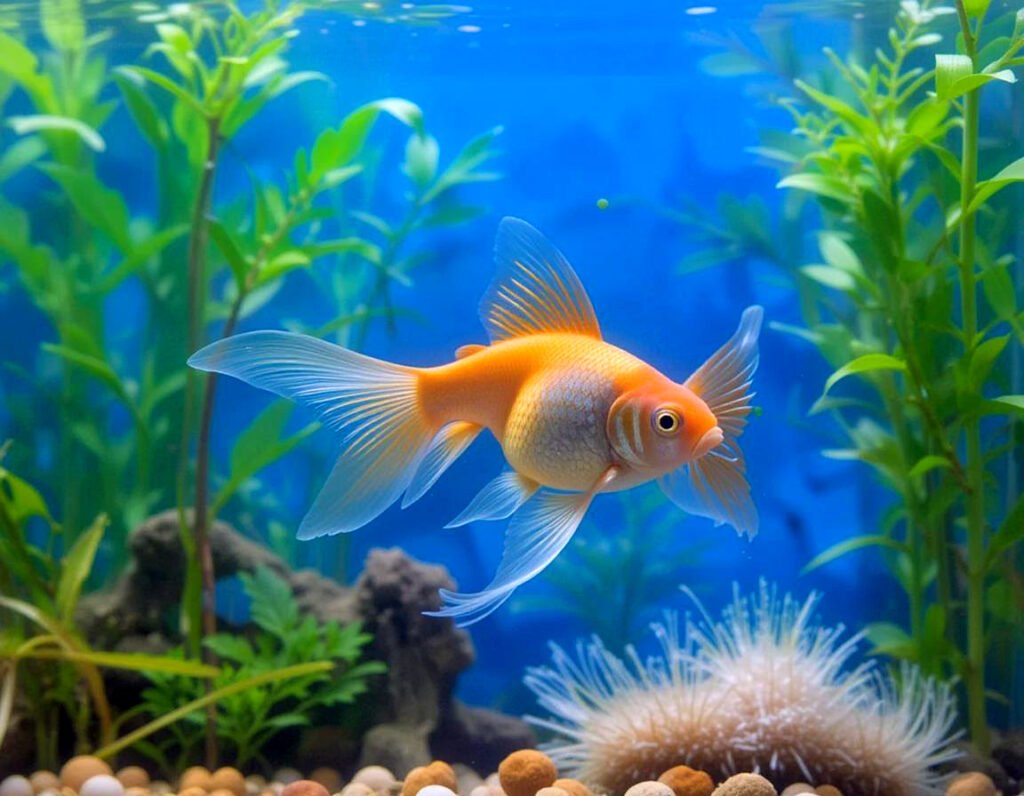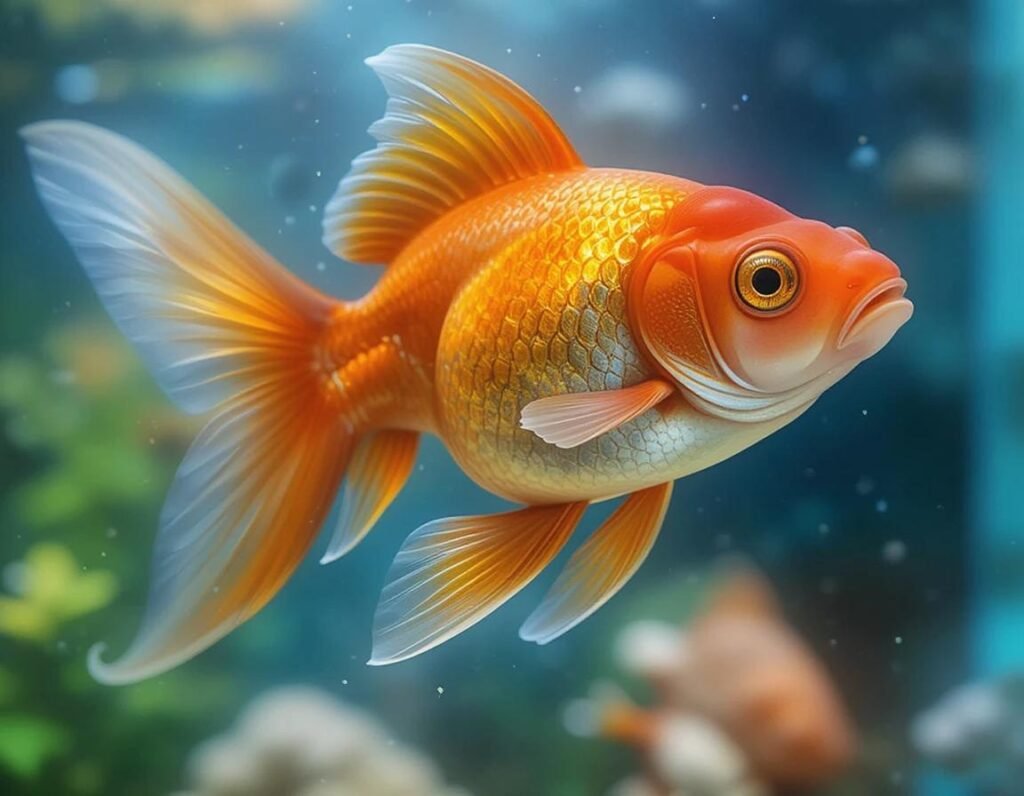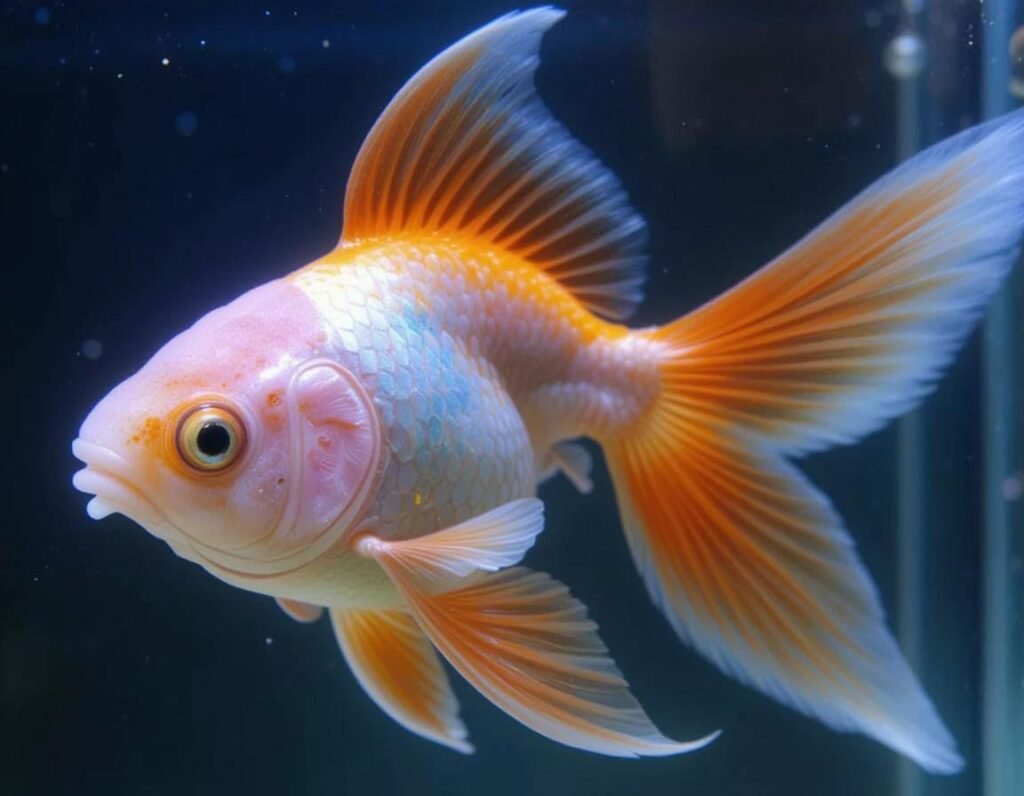
Goldfish are one of the most popular pets in the world, known for their vibrant colors, quirky personalities, and, yes, their surprising intelligence! If you’re a new goldfish owner (or considering bringing one home), welcome to the world of finned friends. Here’s everything you need to know about caring for your goldfish – from feeding and tank setup to avoiding rookie mistakes. Get ready to dive into the ultimate goldfish care guide that’ll have your goldfish swimming in style!
1. Choose the Right Tank: No Fish Bowls, Please!
Let’s get this out of the way: goldfish don’t belong in those tiny glass fishbowls. It’s a myth that goldfish can thrive in small tanks. These lovely fish need space to grow, swim, and stay healthy. Ideally, a single goldfish should have at least a 20-gallon tank. For two goldfish, double that space to around 40 gallons. Remember, goldfish can grow up to a whopping 12 inches, and they need room to show off those fabulous fins.
2. Keep It Clean – The Secret to a Happy Goldfish
Goldfish are pretty messy eaters and produce a lot of waste. Without regular tank cleaning, harmful toxins can build up and turn your tank into a very unfriendly place. Aim to clean 20–30% of the tank water every week, and invest in a reliable filter to keep things fresh. Think of it as housekeeping for your fish—they may not say “thank you,” but they’ll show it with their healthy, shiny scales.
3. Feeding Goldfish: Stick to the “Goldilocks” Rule
Goldfish are eager eaters. In fact, if goldfish could talk, they’d probably convince you to feed them every hour! But be careful: overfeeding is one of the leading causes of health issues in goldfish. Feed your goldfish only once or twice a day and in small amounts that they can finish in under two minutes. And yes, resist the urge to give them “just a little more” – a goldfish bellyache is no fun for anyone.
4. Water Quality: It’s Like Spa Day for Your Fish
Goldfish thrive in clean, balanced water. Testing water quality might sound intimidating, but it’s really easy once you get the hang of it. Goldfish prefer a pH between 7.0 and 7.4 and water temperatures between 65°F and 72°F. You’ll want to test the water regularly for ammonia, nitrites, and nitrates. Think of it as checking in on the fish’s “home vibe” – the better the water, the happier the fish.
5. Give Them a Buddy (But Not Just Any Buddy)
Goldfish are pretty social fish and tend to do better with a friend. However, they don’t get along with just anyone. Goldfish should ideally live with other goldfish or peaceful fish that don’t nip at their fins. Avoid pairing them with aggressive fish like bettas or any species that’s going to hog the food.
6. Avoid Goldfish "Faux Pas"
Even with the best intentions, goldfish owners sometimes make mistakes that can lead to fin troubles. Here are a few rookie mistakes to avoid:
- Overdecorating the tank: Yes, we all love those little castles and plants, but too much decor can reduce swimming space.
- Overcrowding the tank: A crowded tank makes it tough for your fish to stay healthy. Remember the 20-gallon rule per fish!
- Not using a water conditioner: Tap water contains chemicals that are safe for humans but harmful to goldfish. A simple water conditioner neutralizes these chemicals, making it safe for your fish.
7. Health Issues to Watch Out For
Goldfish are generally hardy fish, but they can develop health problems if water quality or diet isn’t up to par. Common issues include fin rot, swim bladder disease, and ich (a common fish parasite). Most of these can be prevented by maintaining a clean tank and following the right feeding guidelines. If your goldfish starts acting odd or looks unwell, act fast and consult an aquarium expert.
8. Enjoy the Company of Your Golden Friend
Goldfish may be fish, but they’re surprisingly interactive! They can recognize their owners, learn to follow your finger, and even perform tricks (for a tasty treat, of course). Spending time watching your goldfish swim around can be incredibly relaxing, and taking good care of them is satisfying.
Wrapping Up
Goldfish are beautiful and rewarding pets, but they require proper care to live long, happy lives. Following these steps will help you build a safe, healthy, and fun environment for your finned friend. And remember, caring for a goldfish isn’t just about keeping a pet – it’s about sharing your life with a curious, colorful buddy who adds a splash of life to your home.
Whether you’re just starting out or a seasoned goldfish enthusiast, embrace the quirks and joys of goldfish care. Just remember, when in doubt, always Google!
Fun Facts About Goldfish to Impress Your Friends
- Goldfish have amazing memories – despite the myth of a three-second memory, goldfish can remember things for months! They can even recognize their owners and respond to routines.
- Goldfish come in over 200 varieties, including fancy varieties like the Oranda, the Black Moor, and the Bubble Eye. Each variety has its own unique look and personality.
- They change color! Goldfish can actually change color over time, especially when exposed to different lighting conditions. If your goldfish turns a bit darker or lighter, it’s totally normal.
- They’re ancient pets – Goldfish were first domesticated over 1,000 years ago in China. They were originally bred from a type of wild carp.
- They can be trained – Believe it or not, goldfish can learn to follow your finger, navigate through hoops, or even do simple tricks (as long as treats are involved!).

Conclusion: Goldfish Are Worth the Effort
Caring for a goldfish isn’t just about adding water and food. It’s a rewarding experience that can teach patience, responsibility, and respect for animals. So if you’ve got a goldfish (or are thinking about getting one), follow this guide and give your fishy friend the best life possible. You’ll be rewarded with a lively, healthy, and happy goldfish – and a new friend who’s always ready to flash a fin at you when you walk by the tank.
Ready to start your goldfish journey? Keep swimming with your new knowledge, and remember: a happy goldfish is a healthy goldfish!
Tips for Bonding With Your Goldfish
Goldfish might not be the cuddliest of pets, but you can still form a unique bond with them! Here are some tips to help you build a closer connection:
- Establish a Routine: Goldfish can recognize patterns, so feeding them at the same time each day can help them get used to you. Soon enough, they’ll swim up excitedly when they see you approach!
- Use Your Finger as a Guide: Gently move your finger along the glass, and watch as your goldfish follows it. This simple game can be a fun bonding exercise, and your fish will get used to your presence in a non-threatening way.
- Offer Special Treats: Goldfish love little snacks like peeled peas (for digestive health) or tiny bits of cooked carrots. Occasionally offering these treats can make you their favorite person! Just remember not to overdo it – they’ll still happily eat their regular pellets.
- Teach Basic Tricks: Believe it or not, goldfish can learn tricks like swimming through hoops or finding their way through a mini obstacle course. With the help of treats, a patient approach, and gentle encouragement, your goldfish might surprise you with their smarts!
- Spend Time Observing Them: Simply sitting and watching your goldfish for a few minutes each day can help you understand their personality and daily behavior. Plus, watching fish swim is known to be relaxing and even meditative.
Setting Up the Perfect Goldfish Tank Environment
Creating an environment where your goldfish can thrive is key to their well-being. Here’s a checklist for setting up a tank that’ll keep them healthy and happy:
- Add Some Live Plants: Goldfish love natural plants, which also help oxygenate the water. Just choose hardy, goldfish-safe plants like java fern or anubias that can withstand a little nibbling.
- Use Smooth Decorations: Goldfish are curious swimmers and can injure themselves on sharp objects. Choose smooth pebbles and decorations without rough edges to keep their fins safe.
- Maintain a Stable Water Temperature: Goldfish prefer cooler water, so they don’t typically need a heater unless you live in a very cold climate. Try to keep the temperature between 65°F and 72°F to keep them comfortable.
- Provide Plenty of Open Space: Goldfish are active swimmers and need space to roam. Avoid overcrowding the tank with decorations so they can enjoy lots of open swimming areas.
Common Goldfish Mistakes (and How to Avoid Them)
Goldfish are resilient, but there are a few common mistakes that can shorten their lifespan. Avoid these pitfalls to keep your goldfish around for years:
- Overfeeding: As mentioned, goldfish have bottomless appetites and will eat as much as you give them. Overfeeding can lead to bloating, swim bladder issues, and even tank pollution from uneaten food. Stick to small portions once or twice a day.
- Neglecting Water Changes: Goldfish produce a lot of waste, which can quickly turn their water toxic. Regular water changes (about 20-30% weekly) are essential for keeping the water clean and ammonia levels low.
- Skipping a Filter: A filter isn’t just a nice-to-have; it’s a necessity for a goldfish tank. The filter keeps the water clean, oxygenates it, and maintains the right flow for your fish.
- Keeping Goldfish in Bowls or Small Tanks: Goldfish need more space than a bowl can provide. Overcrowded or small tanks lead to stunted growth, stress, and shortened lifespans. Aim for at least a 20-gallon tank for a single goldfish and add 10 gallons for each additional fish.
A Final Word on Goldfish Happiness
Goldfish may be simple creatures, but they can bring a lot of joy to your life. With the right care, these colorful pets can live for decades, sharing little moments with you every day. They’re resilient, curious, and have much more personality than most people give them credit for!
If you provide a spacious, clean tank, a balanced diet, and some mental stimulation, your goldfish will thrive. And in return, they’ll brighten up your home with their colors and graceful swimming. So keep learning, keep observing, and enjoy the underwater friendship that only a goldfish can offer!
Who knew taking care of a little golden fish could make such a splash in your life? 🐟
FAQs about Goldfish care guide:
1. How big do goldfish need their tank to be?
Answer: Goldfish need plenty of space! A single goldfish requires at least a 20-gallon tank, and each additional goldfish needs about 10 more gallons. Avoid small tanks or bowls, as these limit growth and can stress your fish.
2. How often should I feed my goldfish?
Answer: Once or twice a day is ideal for feeding goldfish. Only give them as much as they can eat in under two minutes to avoid overfeeding, which can lead to health issues like swim bladder problems and poor water quality.
3. What kind of food is best for goldfish?
Answer: High-quality goldfish pellets or flakes are best, as they contain balanced nutrients. Occasionally, you can treat your fish to small bits of vegetables like peas or lettuce, which help digestion. Avoid feeding them tropical fish food, as it’s not designed for their dietary needs.
4. Do goldfish need a filter?
Answer: Yes, goldfish are messy eaters and produce a lot of waste. A filter helps keep the tank water clean and oxygenated, which is essential for their health.
5. How often should I clean the goldfish tank?
Answer: You should change about 20-30% of the tank water every week. This helps keep ammonia and nitrate levels down, promoting a healthier environment for your fish. Regular water changes, along with using a filter, keep your tank safe and clean.
6. Do goldfish need a heater?
Answer: Not usually. Goldfish thrive in cooler water, ideally between 65°F and 72°F (18°C to 22°C). However, if you live in a very cold climate where temperatures drop significantly, you may need a heater to maintain stable conditions.
7. Can goldfish live with other fish?
Answer: Yes, but choose tank mates carefully. Goldfish are peaceful but produce a lot of waste, so they’re best with other goldfish or similarly hardy, peaceful fish. Avoid aggressive or fin-nipping species like bettas.
8. What are some common health issues in goldfish?
Answer: Goldfish can suffer from fin rot, swim bladder disease, ich (white spot disease), and ammonia poisoning. Keeping the tank clean, feeding a balanced diet, and monitoring water quality regularly help prevent most health problems.
9. How long do goldfish live?
Answer: With proper care, goldfish can live 10 to 20 years – and some even reach 30 years! Regular tank maintenance, good food, and a healthy environment contribute to a longer lifespan.

10. Why is my goldfish changing colour?
Answer: Color changes in goldfish are normal and can result from factors like age, lighting, diet, and genetics. Some goldfish become lighter or darker over time, and it’s usually harmless.
11. Do goldfish get lonely?
Answer: Goldfish are social creatures and enjoy the company of other goldfish, although they don’t get “lonely” like humans do. Adding a second goldfish can stimulate activity, but ensure you have enough space to support multiple fish.
12. Can I keep goldfish in an outdoor pond?
Answer: Yes! Goldfish thrive in ponds, especially in moderate climates. They tend to grow larger in ponds and enjoy the natural environment. Just be mindful of predators and cold weather, as they may need protection in extreme conditions.
13. What is the ideal pH level for a goldfish tank?
Answer: Goldfish prefer a pH level between 7.0 and 7.4. Testing the water regularly and making small adjustments if needed will keep their environment stable.
14. How can I tell if my goldfish is stressed?
Answer: Signs of stress include unusual swimming patterns (like staying at the top or bottom of the tank), clamped fins, loss of appetite, and color fading. Check water quality and diet if you notice these behaviors, as stress often results from poor tank conditions.
15. How do I know if my goldfish is healthy?
Answer: A healthy goldfish will have bright colors, clear eyes, and smooth, intact fins. They should be active, curious, and have a good appetite. Regular observation helps you catch any changes in appearance or behavior early.
16. Do goldfish have good memories?
Answer: Yes! Goldfish can remember things for months and even recognize their owners. They can learn routines, respond to feeding cues, and even follow your finger around the tank.
17. Can goldfish be trained?
Answer: Absolutely! Goldfish can be taught simple tricks like following a finger or swimming through hoops. They’re highly food-motivated, so a few treats and gentle guidance go a long way.
18. What decorations are safe for a goldfish tank?
Answer: Stick to smooth decorations that won’t injure their delicate fins. Avoid sharp rocks or plastic plants, and consider adding live plants like java fern, which can improve water quality and provide enrichment.
19. Why is my goldfish swimming upside down?
Answer: This is a common symptom of swim bladder disease, which affects buoyancy. It can result from overfeeding or poor water quality. Feed your goldfish high-fiber foods like peas (after removing the skin) to help with digestion and adjust water conditions if necessary.
20. How can I prevent my goldfish from getting bored?
Answer: Goldfish are intelligent and benefit from mental stimulation. Add safe tank decorations, occasionally rearrange them, introduce toys like floating balls, and interact with your fish by teaching them tricks. A dynamic environment will keep them active and engaged.
21. Can my goldfish really grow as big as a foot long?
Answer: Believe it or not, yes! Goldfish can grow up to 12 inches, or even larger in outdoor ponds. The small size of most goldfish is often due to tank size restrictions, not their genetic limits. If you provide a big enough tank, your goldfish may surprise you with its growth spurt!
22. How long do goldfish live?
Answer: Goldfish have surprisingly long lifespans – anywhere from 10 to 20 years, or even longer with ideal care. Some goldfish have even lived over 30 years! So, adopting a goldfish is a long-term commitment, but one with a lot of golden rewards.
23. Do goldfish get lonely?
Answer: Goldfish are social creatures and do tend to enjoy having other goldfish around. While they don’t experience “loneliness” like humans, they do seem to be more active and engaged when they have a buddy. Just make sure their tank is big enough to handle more than one!
24. What’s the best food for my goldfish?
Answer: Goldfish are omnivores, so a varied diet is ideal. High-quality goldfish pellets are great, and you can supplement with occasional treats like freeze-dried bloodworms, leafy greens, or small pieces of veggies. Just avoid overfeeding – goldfish are not known for portion control!
25. Can I put my goldfish in an outdoor pond?
Answer: Absolutely! Goldfish thrive in ponds, where they often grow bigger and have a more natural environment. Just be sure to protect them from predators, and keep an eye on the water temperature during extreme weather.


